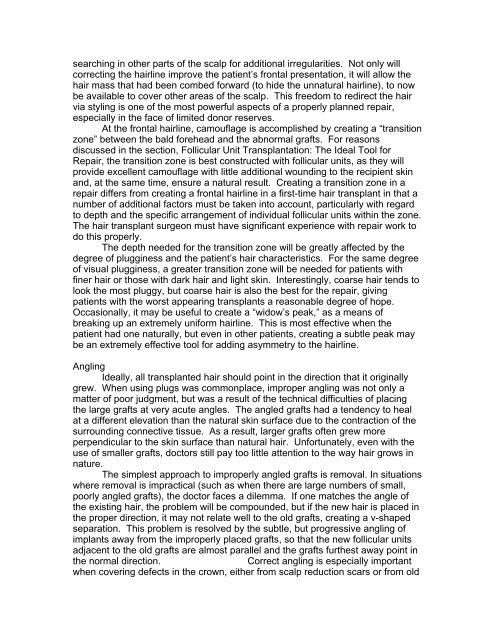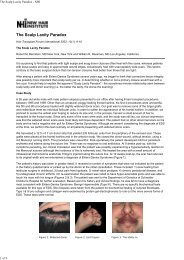The Patient's Guide to Hair Restoration - New Hair Institute
The Patient's Guide to Hair Restoration - New Hair Institute
The Patient's Guide to Hair Restoration - New Hair Institute
You also want an ePaper? Increase the reach of your titles
YUMPU automatically turns print PDFs into web optimized ePapers that Google loves.
searching in other parts of the scalp for additional irregularities. Not only will<br />
correcting the hairline improve the patient’s frontal presentation, it will allow the<br />
hair mass that had been combed forward (<strong>to</strong> hide the unnatural hairline), <strong>to</strong> now<br />
be available <strong>to</strong> cover other areas of the scalp. This freedom <strong>to</strong> redirect the hair<br />
via styling is one of the most powerful aspects of a properly planned repair,<br />
especially in the face of limited donor reserves.<br />
At the frontal hairline, camouflage is accomplished by creating a “transition<br />
zone” between the bald forehead and the abnormal grafts. For reasons<br />
discussed in the section, Follicular Unit Transplantation: <strong>The</strong> Ideal Tool for<br />
Repair, the transition zone is best constructed with follicular units, as they will<br />
provide excellent camouflage with little additional wounding <strong>to</strong> the recipient skin<br />
and, at the same time, ensure a natural result. Creating a transition zone in a<br />
repair differs from creating a frontal hairline in a first-time hair transplant in that a<br />
number of additional fac<strong>to</strong>rs must be taken in<strong>to</strong> account, particularly with regard<br />
<strong>to</strong> depth and the specific arrangement of individual follicular units within the zone.<br />
<strong>The</strong> hair transplant surgeon must have significant experience with repair work <strong>to</strong><br />
do this properly.<br />
<strong>The</strong> depth needed for the transition zone will be greatly affected by the<br />
degree of plugginess and the patient’s hair characteristics. For the same degree<br />
of visual plugginess, a greater transition zone will be needed for patients with<br />
finer hair or those with dark hair and light skin. Interestingly, coarse hair tends <strong>to</strong><br />
look the most pluggy, but coarse hair is also the best for the repair, giving<br />
patients with the worst appearing transplants a reasonable degree of hope.<br />
Occasionally, it may be useful <strong>to</strong> create a “widow’s peak,” as a means of<br />
breaking up an extremely uniform hairline. This is most effective when the<br />
patient had one naturally, but even in other patients, creating a subtle peak may<br />
be an extremely effective <strong>to</strong>ol for adding asymmetry <strong>to</strong> the hairline.<br />
Angling<br />
Ideally, all transplanted hair should point in the direction that it originally<br />
grew. When using plugs was commonplace, improper angling was not only a<br />
matter of poor judgment, but was a result of the technical difficulties of placing<br />
the large grafts at very acute angles. <strong>The</strong> angled grafts had a tendency <strong>to</strong> heal<br />
at a different elevation than the natural skin surface due <strong>to</strong> the contraction of the<br />
surrounding connective tissue. As a result, larger grafts often grew more<br />
perpendicular <strong>to</strong> the skin surface than natural hair. Unfortunately, even with the<br />
use of smaller grafts, doc<strong>to</strong>rs still pay <strong>to</strong>o little attention <strong>to</strong> the way hair grows in<br />
nature.<br />
<strong>The</strong> simplest approach <strong>to</strong> improperly angled grafts is removal. In situations<br />
where removal is impractical (such as when there are large numbers of small,<br />
poorly angled grafts), the doc<strong>to</strong>r faces a dilemma. If one matches the angle of<br />
the existing hair, the problem will be compounded, but if the new hair is placed in<br />
the proper direction, it may not relate well <strong>to</strong> the old grafts, creating a v-shaped<br />
separation. This problem is resolved by the subtle, but progressive angling of<br />
implants away from the improperly placed grafts, so that the new follicular units<br />
adjacent <strong>to</strong> the old grafts are almost parallel and the grafts furthest away point in<br />
the normal direction. Correct angling is especially important<br />
when covering defects in the crown, either from scalp reduction scars or from old



